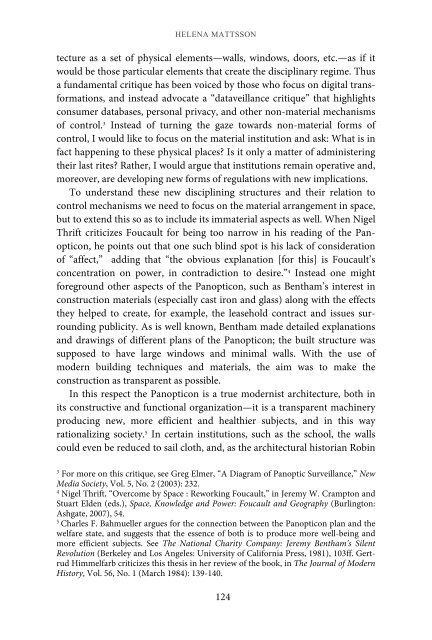Foucault, Biopolitics, and Governmentality
Foucault, Biopolitics, and Governmentality
Foucault, Biopolitics, and Governmentality
Create successful ePaper yourself
Turn your PDF publications into a flip-book with our unique Google optimized e-Paper software.
HELENA MATTSSON<br />
tecture as a set of physical elements—walls, windows, doors, etc.—as if it<br />
would be those particular elements that create the disciplinary regime. Thus<br />
a fundamental critique has been voiced by those who focus on digital transformations,<br />
<strong>and</strong> instead advocate a “dataveillance critique” that highlights<br />
consumer databases, personal privacy, <strong>and</strong> other non-material mechanisms<br />
of control. 3 Instead of turning the gaze towards non-material forms of<br />
control, I would like to focus on the material institution <strong>and</strong> ask: What is in<br />
fact happening to these physical places? Is it only a matter of administering<br />
their last rites? Rather, I would argue that institutions remain operative <strong>and</strong>,<br />
moreover, are developing new forms of regulations with new implications.<br />
To underst<strong>and</strong> these new disciplining structures <strong>and</strong> their relation to<br />
control mechanisms we need to focus on the material arrangement in space,<br />
but to extend this so as to include its immaterial aspects as well. When Nigel<br />
Thrift criticizes <strong>Foucault</strong> for being too narrow in his reading of the Panopticon,<br />
he points out that one such blind spot is his lack of consideration<br />
of “affect,” adding that “the obvious explanation [for this] is <strong>Foucault</strong>’s<br />
concentration on power, in contradiction to desire.” 4 Instead one might<br />
foreground other aspects of the Panopticon, such as Bentham’s interest in<br />
construction materials (especially cast iron <strong>and</strong> glass) along with the effects<br />
they helped to create, for example, the leasehold contract <strong>and</strong> issues surrounding<br />
publicity. As is well known, Bentham made detailed explanations<br />
<strong>and</strong> drawings of different plans of the Panopticon; the built structure was<br />
supposed to have large windows <strong>and</strong> minimal walls. With the use of<br />
modern building techniques <strong>and</strong> materials, the aim was to make the<br />
construction as transparent as possible.<br />
In this respect the Panopticon is a true modernist architecture, both in<br />
its constructive <strong>and</strong> functional organization—it is a transparent machinery<br />
producing new, more efficient <strong>and</strong> healthier subjects, <strong>and</strong> in this way<br />
rationalizing society. 5 In certain institutions, such as the school, the walls<br />
could even be reduced to sail cloth, <strong>and</strong>, as the architectural historian Robin<br />
3 For more on this critique, see Greg Elmer, “A Diagram of Panoptic Surveillance,” New<br />
Media Society, Vol. 5, No. 2 (2003): 232.<br />
4 Nigel Thrift, “Overcome by Space : Reworking <strong>Foucault</strong>,” in Jeremy W. Crampton <strong>and</strong><br />
Stuart Elden (eds.), Space, Knowledge <strong>and</strong> Power: <strong>Foucault</strong> <strong>and</strong> Geography (Burlington:<br />
Ashgate, 2007), 54.<br />
5 Charles F. Bahmueller argues for the connection between the Panopticon plan <strong>and</strong> the<br />
welfare state, <strong>and</strong> suggests that the essence of both is to produce more well-being <strong>and</strong><br />
more efficient subjects. See The National Charity Company: Jeremy Bentham’s Silent<br />
Revolution (Berkeley <strong>and</strong> Los Angeles: University of California Press, 1981), 103ff. Gertrud<br />
Himmelfarb criticizes this thesis in her review of the book, in The Journal of Modern<br />
History, Vol. 56, No. 1 (March 1984): 139-140.<br />
124


